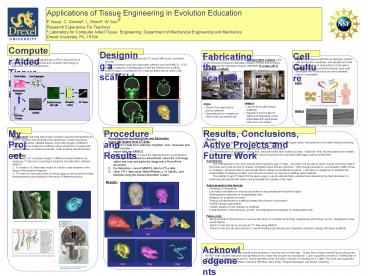Applications of Tissue Engineering in Evolution Education - PowerPoint PPT Presentation
1 / 1
Title:
Applications of Tissue Engineering in Evolution Education
Description:
http://www.duncans.tv/images/geico-gecko-1.jpg. www. ... CT scan of the gecko egg did not work. ... to get CT data from the gecko egg is a good reminder that a ... – PowerPoint PPT presentation
Number of Views:92
Avg rating:3.0/5.0
Title: Applications of Tissue Engineering in Evolution Education
1
Applications of Tissue Engineering in Evolution
Education P. Nuzzi, C. Gomez2, L. Shore2, W.
Sun2 Research Experience For Teachers 2
Laboratory for Computer Aided Tissue
Engineering, Department of Mechanical Engineering
and Mechanics Drexel University, PA, 19104
Computer Aided Tissue Engineering
Designing a scaffold.
Fabricating the scaffold.
Cell Culture
- Patient specific data is obtained from CT scans,
MRI scans, and other sources. - Data is processed using reconstruction software
such as MIMICS. A 3-D image is captured, and
designed to meet the needs of the scaffold. - 3. MIMICS data is converted to STL data so that
it can be used in the fabrication process.
PEDS Hard tissue scaffolds are sterilized,
treated with cell specific substrates, and seeded
with cells and growth factors in preparation for
transplant. MNBDS Soft tissue scaffolds already
have cells embedded into its structure and are
potentially ready for transplant.
STL data is used by a computer to direct
deposition systems such as the Precision
Extrusion Deposition System (PEDS) and the
Multi-Nozzle Biopolymer Deposition System (MNBDS)
to create soft or hard tissue scaffolds.
Computer Aided Tissue Engineering (CATE) is the
science of combining biology, engineering and
computer technology to regenerate 3-D functional
tissues.
PEDS
- MNBDS
- Used to form softer tissue scaffolds
- Alginate (Found in Brown Algae and Seaweed) will
be embedded with appropriate cells and cross
linked.
- PEDS
- Used to form hard tissue (bone) scaffolds
- Nanosized pores created are where cells are
seeded into.
www.cs.cmu.edu/People/tissue/tutorial.html
MNBDS
Results, Conclusions, Active Projects and Future
Work
My Project
Procedure and Results
- Procedures for reconstruction and fabrication
- using 3-D images from CT data
- 1. Collect CT data from veterinary hospitals,
zoos, museums and other sources - Import data into MIMICS.
- Use region growing to select the data desired
for reconstruction. - For images to be used in a PowerPoint, select the
3-D image option and copy and paste the image
into a PowerPoint document. - For fabrication, convert MIMICS data to STL
data. - Open STL data using MotionPlannerTM or
ZprintTM and fabricate using the desired
deposition system.
Background Teaching high school evolution
requires that students be able to compare and
study the DNA sequences, protein structures,
organ compliments, skeletal shapes, and
embryologies of different animals. 3-D
reconstruction software allows students to
compare the skeletal shapes of numerous animals,
while avoiding animal sacrifice. Objectives 1.
To create 3-D computer images of different animal
skeletons by acquiring CT data and converting it
using the reconstruction software MIMICS. 2. To
create a 3-D fabricated model of a skull to aide
students in the study of the foramen magnum. 3.
To make 3-D reconstructions of Gecko eggs at
various points in their development to aide
students in the study of different embryos.
- Results
- - 3-D reconstruction and fabrication of the Pig
and the Human, skull and upper spine, look great
and will make valuable teaching tools. - - 3-D reconstructions of Human, Cat and Dog
skulls were successful. - - 3-D reconstruction of Dog spine, pelvic area,
and lower limbs also looked accurate. Additional
limb reconstructions are needed. - - CT scan of the gecko egg did not work. An
improved protocol for scanning reptile eggs must
be researched. - Conclusions
- The limiting factor in my work was the
time required to get CT data. I feel that I will
be able to obtain a large amount of data in the
future due to the amount of already completed
scans that are out there. With enough
persistence, and possibly a little money for
postage, I should be able to get enough data to
design some effective lessons. I also plan on
assigning my students the responsibility of
seeking out data, which should increase our
chances of getting useful material. - The inability to get CT data from the
gecko egg is a good reminder that a scientist
must determine the best practices for
performing all experiments before using valuable
lab supplies of any type. - Active projects in the Sun lab
- - Modeling of vasculature.
- Liver tissue simulation on microscope slides for
drug metabolism studies in space. - Testing stress tolerances of encapsulated cells.
- Building 3-D scaffolds for bones.
- Testing cell attachment to scaffolds treated with
plasma or fibronectin. - Scaffold design optimization.
- Viability studies of cells seeded on scaffolds.
- Characterization of the behavior, growth, and
angiogenesis properties of encapsulated cells.
Results
Human
http//www.duncans.tv/images/geico-gecko-1.jpg
Pig
Acknowledgements
I would like to thank Dr. Wei Sun and all of the
members of the Sun lab for their help. Id also
like to thank Joanne Ferroni along with the RET
staff, and the instructors and professors who
made this program so educational. Last I would
like to thank Dr. Wilfreid Mai at the University
of Pennsylvania and Dr. Susan Hartman at the
University of Illinois for sending me CT data.
This work was supported by the National Science
Foundation (Award 0601845, Mary Poats, Program
Manager) and Drexel University.
www.indiana.edu/oso/evolution/EvolMorphol_files/i
mage002.jpg
Cat Dog
Dog
www. carolina.com/anthropology/hominid
_skulls/measurement_guide.asp































